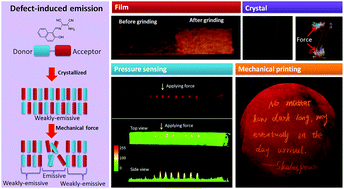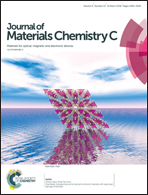A turn-on type mechanochromic fluorescent material based on defect-induced emission: implication for pressure sensing and mechanical printing†
Abstract
In principle, mechanochromic fluorescent (MCF) materials can be classified into two categories: turn-off and turn-on types. The latter is superior to the former as it is more sensitive and less likely to induce false-positive signals. In this study, we report the synthesis and photoluminescence (PL) behaviour of a biplane molecule, 2-amino-3-((E)-((2-hydroxynaphthalen-1-yl)methylene)amino)maleonitrile (AHM), which consists of an electron donor (D) plane and an acceptor (A) plane. AHM undergoes both aggregation-enhanced emission (AEE) and intramolecular charge transfer (ICT) mechanisms. It is weakly emissive in the crystalline phase but shows a remarkable emission enhancement with a large bathochromic-shift (67 nm) upon applying mechanical force. As confirmed by both spectroscopic methods and fluorescence microscopy, MCF arises from crystal defects, where the molecules would twist their conformation to break D–A coupling, inducing strong fluorescence. This defect-induced emission (DIE) endows the material with ultra-high sensitivity toward pressure. The detection limit (DL) of an AHM-based sensing film is as low as 1.1 N (0.62 MPa). Additionally, the DIE phenomenon of AHM further enables a new mechanical printing technique. Handwriting and imprinted letters exhibit a distinct emission change which is readily detected by the naked eyes. We believe that the unique turn-on MCF and high sensitivity make this material well-suited to tackle the challenges faced by conventional MCF materials.



 Please wait while we load your content...
Please wait while we load your content...